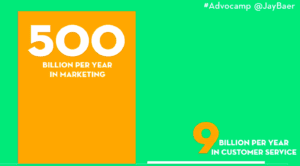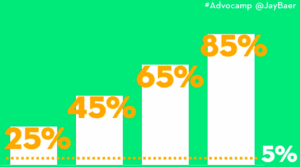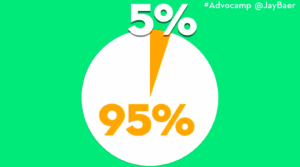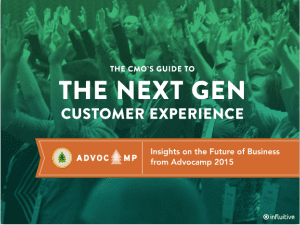Every business will get complaints.
It doesn’t matter what business you’re in. It doesn’t matter if you’re selling cars or t-shirts or software; at some point some of your customers are going to have feedback like this example. This is an actual review on TripAdvisor for a Chicago-area location of the White Castle hamburger chain.
“While driving to the airport near the end of our Midwestern journey, I heard what appeared to be hyperventilating coming from the back seat of our rental car. My 16-year-old could not believe he was actually seeing a real, live, bonafide White Castle, and he begged us to go in. Since we were pretty early for our flight, we decided to go ahead and let him have his ‘Harold and Kumar Go to White Castle’ moment, a movie which he asserts is the greatest stoner film ever. Stoner film, like there’s a category for it at Sundance.”
Stoner film, like there’s a category for it at Sundance. That review seems pretty positive. White Castle, you’re like right on, high five! But there’s a second half of the review.
“I cannot believe that these people actually exchange real American currency for this square steamed mixture of rodent feces and sawdust on a tiny bun. This is the bastard love child of a 7-11 microwaveable meat patty and the end-trail drippings of roadkill left to fester on Midwestern highways in the hot July sun. Happily, it’s as thin as a Post-It note, so as not to avoid inadvertently engaging your gag reflex.”
So, that took a turn for the worse. I have three observations.
- White Castle is not a sponsor of Advocamp 2017.
- As a consultant—I want to let this go out for free—anytime you see the words ‘rodent feces’ in a review, it’s almost always negative.
- This is a true story, this is a two-star review. I want to know what this person’s one-star review sounds like so badly! Please write a one-star review and get back to me.
Now, the natural reaction would probably be to ignore this and say that these are the rantings and the ravings of a crazy person, and I’m going to ignore and dismiss this. But that, my friends, is the worst possible thing that you could do.
The numbers behind complainers
Earlier this year I did a huge research project on the science of complaint. Who complains, where they complain, why they complain, and how. What I found was remarkable. I found that not answering a complaint decreases customer advocacy every time and in every channel. It takes a bad situation and it makes it worse.
However, when you answer a complaint, it increases customer advocacy every time and in every channel. It takes a bad situation and it makes it better. Today, one-third of all customer complaints are ignored. Almost all of the customer complaints that are ignored are online, where everybody can see you ignoring them, which seems strange because no response is interpreted as a response; a response that says “We don’t care about you at all.” It’s pretty hard to trigger advocacy when you won’t even respond.
What we discovered is that the people who complain about your business, the ‘haters’ if you will, aren’t your problem. Ignoring them is. What you can do instead is to embrace complaints, all of them, and hug your haters. Use negative customer feedback to differentiate your business and create the advocates that we’re here to celebrate at Advocamp. What that requires is that you answer every complaint, in every channel, every time.
Every complaint, every channel, every time.
Does that require resources? Absolutely, but it is exceptionally worth it to put those resources into this kind of program. Hugging your haters makes you money. This is not just theory, it is fact. Every single person in this room learned this on the first day in business—in fact, you learned this by the first day at lunch in business—that it makes more sense to keep the customers you’ve already earned than it does to constantly have to refill that metaphorical leaky bucket with customer acquisition and more customers.
There’s no argument to that, and there’s no other side of that equation. But we don’t actually run businesses that way. Each year, globally, we spend about 500 billion dollars on marketing and about 9 billion dollars a year on customer service.
That probably doesn’t actually make sense, and I say that as a marketing consultant. If somebody in your organization, or maybe even you, says, “Oh, that makes sense. Maybe we should put more money into customer service, but we don’t have those resources”, I say to you that is totally bullshit. You of course have the resources, you just choose to not deploy them that way, and that’s on you, because this actually works.
The research shows that just a five percent, just a five percent, increase in customer retention can increase profits by 25 to 85 percent because of the multiplier effect that happens when you hold onto customers longer. It also allows you to spend less on marketing because you’re not having to refill that bucket all the time.
There are tremendous financial advantages to focusing on your current customers. Customer service is in fact the new marketing—but only if you choose to engage. Customer service is the way to separate your business from competitors in your category. I know this to be true because if I ask you who’s really good at customer service, everybody in this room can come up with two or three names like that. You can instantly come up with names. Why? Because they are so rare. They are exceptional, which is why they are memorable. My vision is that we get to the place within 12 or 18 months where enough people understand this ‘hug your haters’ principle that, when I ask you who’s great at customer service, you can’t name anybody because so many companies are good at it that they no longer stand out.
That’s where we should be, but it’s not where we are today.
 Free eBook: The Key to Unlocking Customer Advocacy
Free eBook: The Key to Unlocking Customer Advocacy
Most B2B companies say the customer experience is a priority, but their teams are not prepared or coordinated enough to make this a reality.
It starts with strong alignment between customer success and marketing.
This partnership has the power to unlock the true potential of your customers: genuine advocacy that will help you grow your business faster.
Offstage versus Onstage Haters
I want to tell you a little bit more about complainers and who they are. I want to introduce to you ‘the hatrix.’ In the research, we discovered that there’s actually two main types of people who complain, two main categories of haters.
- The first are called offstage haters. Offstage haters complain in legacy channels, so phone and email typically. They’re slightly older, slightly less technology-savvy.
- The other group are called onstage haters, and onstage haters complain in public: social media, review sites, discussion boards and forums. They’re a little younger, a little more social media savvy, as you might suspect.
But the big difference between offstage haters and onstage haters is what they expect of you. When people complain on the phone or email, they expect and want an answer. They want an answer- in fact, 90 percent of the people who complain offstage expect a reply and I’m sure that’s true for you. If you call a business, if you email a business, you fully anticipate that they will get back to you. It’s just part of the social contract. It’s how business has evolved over the last 15 or 20 years. They expect a reply. Sometimes that reply can be difficult to summon because sometimes when people call or email they can really go on a bit of a rant like this guy who left this voicemail at the Jimmy Dean Sausage hotline.
“Randy Taylor. I don’t know where you people come from, and I don’t know if you test the quantity of your product. Your product is very delicious. I’ve loved your sausage for 30-something years, but I can’t take and feed a family of five on a little 12-ounce roll of sausage. I don’t mind paying you more money for your 16-ounce roll of sausage, but you don’t have it anymore. You’ve got a 12-ounce roll and you’ve got three men that weigh over 200 pounds apiece, a woman that’s a little plump Dutch girl, and a daughter who’s 13, and you’re going to try to take a 12-ounce roll of sausage and a couple of dozen eggs and feed that? It ain’t going to work and I’m not going to purchase your product anymore or ever again.
As far as your 16-ounce in maple and sage goes, I don’t eat that. I’m not from the north, I’m a Texas man. Jimmy Dean Sausage is for southern people to eat with their breakfast, with the fried eggs and the t-bone steak, and I can’t see going to a little 12-ounce package to feed four, five, six people, and I’m not going to buy two of those 12-ounce packages just because you want to downsize and charge the same goddamn price. I’d sure like a reply and I’d sure like you to go back to your 16-ounce package on your regular sausage because I’m not going to buy it otherwise ever again. I’ll just have my own damn sausage made like I used to 30-something years ago. It’s not as tasty as yours is but it’ll work. Goodbye.”
Let’s hear it for Randy Taylor, a man with an acute sausage problem. This is a real problem, but when you listen to that more closely, wait a second. There’s four or five people and he’s got two dozen eggs- that’s five eggs per person. Why do you even need sausage? Five eggs a person? What are you talking about? I’m not sure the math adds up on that, but we’ve got to hug those offstage haters, even people like Randy. He actually said in the voice mail that he sure would like a reply. Nine out of ten of those offstage haters want a reply from you.
The onstage haters, the people who complain in social media and beyond, have a different story. They don’t necessarily want an answer; what they really want is an audience. They don’t necessarily expect that businesses or brands will get back to them, partially because they usually don’t. As I mentioned, a third of all complaints are ignored. Most of those are online, and so only 47 percent, according to the research, only 47 percent of people who complain in public, social media, and beyond, actually expect or anticipate a reply.
This is an enormous opportunity to create advocacy, because they don’t expect to hear back. So when they do hear back from you, when you do answer them in these places and in these contacts that they have not been trained to expect businesses to participate, what happens? It blows their minds and wins their hearts. This is the single greatest advocacy-creating opportunity on the customer service side of the ledger right now in business: to answer customer complaints in the places and the venues that they do not expect it.
This opportunity may not last forever, but it is very much present today. Answering just one customer complaint in one of these online and public channels can increase advocacy by up to 25 percent. The research proves that customers who have had a problem, and whose problem was successfully resolved by the business, become stronger and more powerful advocates for the brand than customers who never had a problem at all. It’s like a weird Stockholm Syndrome kind of situation, a we’re all in this together, bunker mentality- you solved my problem, now I’m with you. It’s a powerful, powerful psychological motivator.
The other thing we can’t forget, in addition to the advocacy benefits of hugging our haters, is that haters are the canary in the coal mine. They are the early warning detection system for your business, for my business, for every business. They are the ones who tell us what we need to be told. While we sometimes grouse and complain about negativity, haters and complainers are mathematically quite rare. In fact, research from Fred Reichheld and Bain shows that only five percent of dissatisfied customers ever complain in a form or a fashion that the business can find it.
Five percent, which means that 95 percent of the people who are unhappy with you just disappear. They just disappear, they’re just gone. Whatever happened to Larry? He used to come in all the time. That’s one of those people who just left. They didn’t even tell you.
As Joseph Jaffe talks about all the time, love and hate are equally important. The people who actually take their time to tell you what you could do better? That passion is incredibly important. They care enough to say something and that should be rewarded, because what this 95 to five ratio means is that haters and complainers are actually the unelected representatives of this larger group of dissatisfied customers that I call the ‘meh’ in the middle. They’re the people who don’t really care enough to tell you, so they just leave and go to your competition.
The benefit of hugging your haters
When you think about this, the haters and the complainers are actually your most important customers. They’re the most important customers for your business, yet we treat them routinely, strategically and purposefully as the least important customers. All the time I hear things from businesses like, well, you know what, that customer’s lying. They’re just a bad customer. If that’s how they feel, we didn’t want to work with them anyway.
That’s a very dangerous way to run your organization, very dangerous indeed. You can take these complaints and use them to manifestly improve your organization. Le Pain Quotidien is a chain of bakeries and cafes. They’re based in Brussels. They have about 220 locations; there’s some in southern California—I don’t think any appear in NoCal—and there’s also some in the northeast. Erin Pepper, their director of customer experience, when she started a couple of years ago she said that her goal was to triple the number of complaints that they got.
Think about that. She wants to triple the number of complaints, not because she wants to work in a worse company, but because she understands that if she can take that ratio from five percent to 15 percent, the people who actually say something when they’re unhappy are gold. That’s free market research.
She has another program that’s truly remarkable. I want every single person in this room to steal this idea. In their business, restaurants, negative feedback would typically be on Yelp or TripAdvisor or UrbanSpoon, or one of those type of sites. When they get a negative review, she answers back publicly. I’m terribly sorry, we’re going to use this information to make this better, we’re going to talk to the store manager, et cetera. The usual, well done, playbook, answers in public every time, great.
It’s what she does next that’s so noteworthy. Usually she lets it lie for two or three hours and then she hits them back with a private message. All of those sites, of course, have a private messaging function behind the scenes. She sends them a private message that says “Hey, I just responded to you in public, but I’ve been thinking, and you are a particularly perceptive customer. You have a gift for this. You see things that other customers simply do not see. What I’d like to do, with your permission of course, is send you two gift cards per month. With each of those gift cards, I’d like you to visit a different Le Pain Quotidien location, and upon the conclusion of your meal, I’d like you to click this link and fill out this very, very, very detailed survey of your experiences because you understand what we’re trying to achieve here. You see things on the margins that other people would simply ignore. Will you do that for me?”
It totally works.
She has 200 of these secret shoppers working for her constantly now, filling out these very detailed assessments of their experiences. The total cost of that program? Some gift cards. You know what it would cost you to actually have a professionally managed secret shopper program of that magnitude? Thousands, and thousands, and thousands of dollars. She’s like, “I’m not going to do that, I’m just going to turn hate into help.” Ta-da.
The overrated nature of praise
The most overrated thing in business, the most overrated thing in life, is praise. Praise is vastly overrated because every time somebody says to you, “Oh you’re so great at this, you’re so great at that,” it makes you feel amazing. But it almost never teaches you anything because we almost always know what we’re good at. We already know what we’re good at. It’s emotionally resonant, but it’s not instructive. What teaches you lessons that you need to learn are negative feedback: complaints and criticism. Complaints are the petri dish of operations improvement. They’re gold. That’s the stuff that we should be listening to.
One of my favorite examples of this in practice is from KLM, Royal Dutch Airlines. KLM is based in Amsterdam. They had a program for a long time, and actually many airlines did it this same way, and still many do, where if you left something on the plane—I’m on my 14th pair of headphones as a result—what would happen is that the flight attendant or the cleaning crew would go through the plane, and they’d find it, and they’d be like, “Okay, seat 11D, here’s some headphones.” They would put a Post-It note on it, and then they’d take it to a desk. Not a department, but actually a desk, and they’d put it on there and they’d say that this was found on flight 162, and then on the back end people would call in or tweet, and say that they lost their headphones. The airline would direct them to click a link to fill out this really detailed form, and then they’d get the form back and they’d try to match up the form with the desk and the Post-It notes. The whole thing was just a cluster. This is 2014, and this is still the way things were done.
A lot of customers were starting to complain on Twitter and beyond about “Hey, you know what, this is how hard is it to get my headphones back.” This seems a little bit ridiculous. And so, one of their team members there, because they really do empower their employees to work off-script and create advocacy without permission—which I think is an important principle—she said, “I think maybe there’s a better way to do this. If you find anything on a plane, just give it to me. Don’t put it on the desk, just bring it to me and I’ll figure it out.” Most of the time people who are flying through that airport are going somewhere else—it’s very much a way station, Amsterdam’s airport. She would look people up on the passenger manifest, and in many cases they were still in the airport waiting for their flight so she’d just bring the item and say “Hey, I think you lost this.” It was so successful she ended up getting some help for it.
How about that for advocacy? Chances of you being an advocate when a beagle brings you your sunglasses—143 percent, roughly. It’s not official math, but it’s something like that. Isn’t that great?
How to hug your haters
First thing is to be fast everywhere. It goes without saying that we’re living in an era that values speed. 40 percent of social media complainers expect a reply within one hour. The average amount of time it takes a business to reply to social media complaints, when they reply at all, is five hours. They want it in one, we give it to them in five, that is a real problem. We’ve got to be faster. Speed matters. You can actually build a whole business based on speed.
The second tip I want to give you, in the interest of time, is that it’s really easy to blame customers, as I mentioned. To say it’s their fault, they’re bad, they’re lying, et cetera. What I’ve discovered in my research, and in my life, is that in many cases the customers aren’t lying—it’s just a difference of opinion. This happened to me and I’m going to tell you a story about how this works.
In 2001, my very best friend from second grade moved to Arizona, where I’m from originally, from New York. He ended up marrying my wife’s sister, so my best friend became my brother-in-law, which I totally recommend. If you can socially engineer that, it’s amazing. My best friend is my brother-in-law, and this is before anybody had kids, and so the four of us were like an episode of Friends. We’re just hanging out, it was awesome, and so I was 32, he was 32, we were all 32, and he unfortunately was diagnosed with brain cancer. He had a series of increasingly invasive brain surgeries and one of the byproducts was that he lost the power of speech. He was okay-ish otherwise, but he couldn’t say anything. They were just like, “Well, we got to take that part out.”
At the same time, some of you may remember this, the Arizona Diamondbacks, the baseball team, which I had season tickets to for the whole time, played in the World Series against the New York Yankees. This was two weeks after 9/11, so it was very high security. There was all kinds of extra security brought in for the game. They were so concerned that they welded all the manhole covers shut for a mile around the stadium. People were really freaked out. I had season tickets and I had tickets to game seven, Diamondbacks versus Yankees, and I knew there was only one person I would take to the game: my brother-in-law, Al from New York.
So he and I go to the game. I forgot to tell you that about two weeks earlier, my other friend Pete, and the tickets were actually in his name, had lost all the playoff tickets. I don’t even know how you do that, like if the beagle ate them or whatever, but he lost all the playoff tickets. What we’d have to do before every game is go in and say here’s our ticket number and our ID, and they’d reprint them right there on the old, shitty dot matrix printer, and they’d give us the tickets. We go to game seven, we sit down, first inning, Al pantomimes he’s going for a cigarette. I know it’s not socially acceptable now, but this was 15 years ago and if you have brain cancer, smoke them if you got them is the way I look at it. He goes down the left field line to the smoking patio and an inning goes by, and a second inning goes by, and I’m like what is going on, he’s missing the World Series, I should go find him.
I go on the hunt. I walk out the door, and outside a little alcove there, and he is up against a brick wall in handcuffs with a security guard yelling at him. I burst out of the door and I’m like, “Wait, what’s going on?” He’s like, “Are you with him?” I’m like, “Yeah.” Boom, he puts me up against the wall and handcuffs me.
Now the two of us are standing there, up against a wall, in handcuffs, with the World Series going on just over there. And so we stood there. Turns out that because our tickets didn’t look the same as everybody else’s—we had the reprint tickets, not the souvenir hologram tickets—they thought the tickets were fake and that we were part of some sort of terrorist cell. It certainly did not help that Al could not respond to any questions. We were there for an inning, and a second inning, and a third inning, and a fourth inning, and a fifth inning. About two hours we stood there, and eventually out of the corner of my eye I saw somebody that I knew worked for the team and so I said, “Hey.”
He comes over and is like, “What are you doing?” I’m like, “The tickets,” and he says, “Oh yeah.” He goes to get a guy from the ticket office and they’re like, “Oh yeah, these guys are fine.” They un-handcuff us and that was it. No I’m sorry, no enjoy the game, no pat on the head, not a single word. Just un-handcuffed us and that was it. We got back to our seats and we’re like “Wow, that was crazy,” but we got back just in time for the bottom of the ninth inning where the Diamondbacks won the game on what some people say is the greatest play in the World Series history.
I remember it like it was yesterday. It was so visceral and powerful in my mind. The stadium’s going crazy, I’m super happy, Al’s super unhappy because the Yankees lost. It was really something.
Al died shortly after that and for a long time, I was really bitter about the whole thing. I felt like, how dare they. They robbed me of this experience with my best friend and my brother-in-law, and they were wrong. I wrote a long letter, offstage hater-style. I was really upset about it for a really long time.
Now, with some distance, I think about it differently. I realize that officer, that security person who was not one of the regular Diamondbacks officials, was brought in because of 9/11 from some other agency. He was doing exactly what he was trained to do. He was doing exactly what he was supposed to do. He didn’t know that there were other tickets, he certainly didn’t know that Al had brain cancer, and he certainly didn’t know that Al had lost the power of speech. He didn’t have all the information: he only had this much of the information.
That is so true of our customers as well. In many cases we have this tendency to blame them, but they only can see what they can see. They don’t know all the circumstances in your organization. They don’t know that somebody was out sick, or that you changed managers, or whatever the excuses are. They don’t know and they don’t care. They can only see what they can see, so the next time you’re tempted to blame a customer instead of hugging a customer, I want you to remember that story and make sure that you’re not using a difference of perception and a difference of opinion as an opportunity to slam somebody who probably doesn’t deserve it.
My friends, 80 percent of businesses say that they deliver exceptional customer service. 80 percent. However, just eight percent of their customers agree, according to Bain. That’s a problem. We’re not nearly as good at this as we think. But we can be. You can be, we can all be. We can use this as a way to create and propagate advocacy in a powerful, efficient, cost-effective way. It requires you to answer every complaint, in every channel, every time. Does that take time and resources? It does. I hope you recognize now that it is worth doing so. You can create advocates and set your business apart simply by hugging your haters, because your competition can and will steal everything from you. They’ll steal your marketing, they’ll steal your best customers, they’ll steal your best employees, they’ll copy your trade show booth, they’ll get a bear suit or a canoe. Whatever they need to do, they will.
The one thing they can never take from you, the one thing they can never take out of your hands, the one thing that is yours and yours alone, that is always yours and will always be yours, is if you genuinely care more about your customers than they do. That’s what creates advocates, that’s what builds companies, and I hope you’ll follow that path.





















































